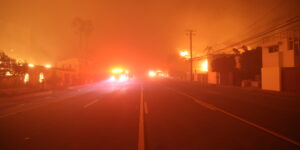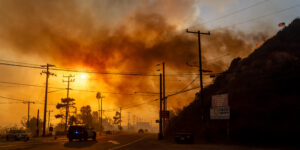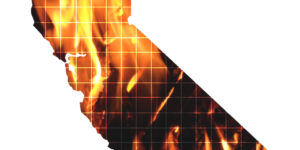As a massive winter storm dumped snow across much of the western U.S. earlier this week, some hardy winter sport enthusiasts headed to ski resorts and backcountry slopes despite frigid temperatures.
But in many areas, the storm brought a high risk of avalanche conditions along with the wind and snow, with fatal results.
In northern Idaho, two men were rescued after they were caught in an avalanche on Thursday, while the body of a third man in their backcountry skiing group was located Friday. On Thursday night the occupants of two vehicles escaped without injury after an avalanche buried their cars in another part of the state.
The first reported U.S. avalanche death of the season happened Wednesday in California, on a section of expert trails at the Palisades Tahoe ski resort near Lake Tahoe. Four people were trapped and one was killed in that slide. A second avalanche struck the same area the following day, with no reported casualties.
Here’s a look at why, when and how avalanches occur, and some tips on how to stay safe from slides:
Why do avalanches occur?
It generally takes just two ingredients to create avalanche conditions: A slope of 30 degrees or more, and layers of snow.
“Avalanches are really tied into having layers within the snowpack, and those layers are caused by weather conditions,” said Ben Bernall, an avalanche forecaster with the U.S. Forest Service Panhandle Avalanche Center. “It’s kind of like a cake: You might have a nice thick layer that’s good and cohesive, and then a thinner layer of frosting. Then put another cake on top of that, and throw in the factor of a slope angle or steep terrain.”
Extra pressure on top of that snowpack “cake,” from wind, rain, heavy snow or motion can cause some of the layers to shear off and slide down the slope, Bernall said.
Sometimes that slide happens in the form of loose snow, called a “sluff.” Sluffs account for only a small percentage of deaths and property damage from avalanches, according to the Sierra Avalanche Center.
But many avalanches are made up of slabs, where a large layer of snow breaks away and slides down the mountainside. Those account for most fatalities.
Another kind of avalanche occurs when wind creates a cornice of snow that hangs over a ridge or the edge of a steep slope. An overhanging mass of snow can fall suddenly, catching anyone standing underneath or on top of the cornice by surprise, according to the Colorado Avalanche Information Center.
What triggers an avalanche?
Movement, rapidly changing weather, wind — any one of these things can cause an avalanche. But experts say 90 percent of the avalanches that cause injuries or deaths are triggered by the victim or someone with them.
That means that people who ski, snowmobile, snowshoe or enjoy other activities in the snowy backcountry should check the avalanche forecast before they head out, and make sure they have the right safety gear.
Most ski resorts have avalanche protocols or mitigation systems. Often that means checking snowpack stability. Avalanche experts and ski resorts also sometimes use remote detonations to trigger slides manually, removing the riskier layers of snow, before skiers are allowed on the slopes.
What doesn’t trigger an avalanche?
Loud noises, generally. Despite what cartoons and movies might have you believe, the sound waves created by someone yelling aren’t enough to trigger an avalanche, according to the Sierra Avalanche Center.
In particularly unstable snow conditions, however, an extremely loud noise, such as from a nearby explosion, could do the trick.
How common are avalanches?
An average of about 28 people die in avalanches every year in the U.S. according to the Federal Emergency Management Agency. Last winter, 30 people died in avalanches in the United States. They all were skiers, snowboarders, snowmobilers, snowshoers, climbers or hikers.
Last February, three members of a mountain climbing club from New York perished in an avalanche on a remote peak in the Cascade Mountains of Washington state.
Three climbers in Alaska’s Denali National Park died in May in two separate incidents on the same day. One triggered an avalanche while skiing in the park’s backcountry. Two others were swept away as they prepared to climb a peak known as Moose’s Tooth. Their bodies were never found.
Where do most avalanches occur?
The vast majority of avalanche deaths occur in the wilderness. They’re rare at ski resorts where crews manage the slopes and trigger smaller slides on purpose when no one is around.
“In the last 10 years, there have been 244 people killed in avalanches in the U.S. and only 3 percent of those were in open, operating areas of ski resorts,” said Ethan Greene, director of the Colorado Avalanche Information Center. But he said it’s impossible to eliminate them.
“We are dealing with Mother Nature. We are dealing with a natural hazard in very complex systems in mountain environments. We can’t remove the risk completely.”
How can someone avoid an avalanche?
There are several ways to avoid an avalanche, but running isn’t one of them. Dry slab avalanches typically reach speeds up to 80 mph (129 kph) within seconds, according to the Sierra Avalanche Center. Wet avalanches usually travel around 20 mph (32 kph).
By comparison, eight-time Olympic gold medalist Usain Bolt set a record of just under 28 mph (45 kph) in the 100-meter dash in 2009 — and that was on a flat track, not a snow-covered slope. Most people caught in avalanches are on the slope when they occur.
A better plan is avoiding them altogether. Recreationists can check forecasts at regional avalanche centers or www.avalanche.org.
If you dare venture out, it’s a good idea to use the buddy system and be versed in wilderness first aid. Bernall said three pieces of gear are essential: an avalanche beacon or transceiver, which sends location signals to others; a shovel to test snowpack or dig out companions; and a thin, folding pole to poke into the snow in search of anyone buried.
Boise County Sheriff Scott Turner said the best bet this weekend in the backcountry of central Idaho is to stay on lower elevations and away from steep slopes.
“People have been waiting for the snow to recreate,” he said, “but the snow conditions right now aren’t good.”
What if you get caught in an avalanche?
As fast as you can, try to cover/cup your mouth and nose with your hands. If your arms are extended when you’re buried, you won’t be able to move them.
The cupped hands provide a tiny air pocket. And your breath is warm when you blow out (try it), so it can help melt the snow. If you’re lucky, you might be able to wiggle a finger or two to slowly dig through otherwise cement-like snow for space with more air to breathe, and eventually lead to an escape.
Associated Press writer Scott Sonner contributed to this report from Reno, Nevada.





















 Mixed Bag: What Trump 2.0 Tariffs, DOGE Activities Mean For Insurers
Mixed Bag: What Trump 2.0 Tariffs, DOGE Activities Mean For Insurers  Property and Casualty Insurance Trends for 2025
Property and Casualty Insurance Trends for 2025  Swiss Re’s Business Unit CEOs Share Views on Key Risk Themes of 2025
Swiss Re’s Business Unit CEOs Share Views on Key Risk Themes of 2025  Surviving the ‘Silver Tsunami’: Closing the Talent, Skills Gap in Underwriting
Surviving the ‘Silver Tsunami’: Closing the Talent, Skills Gap in Underwriting 




